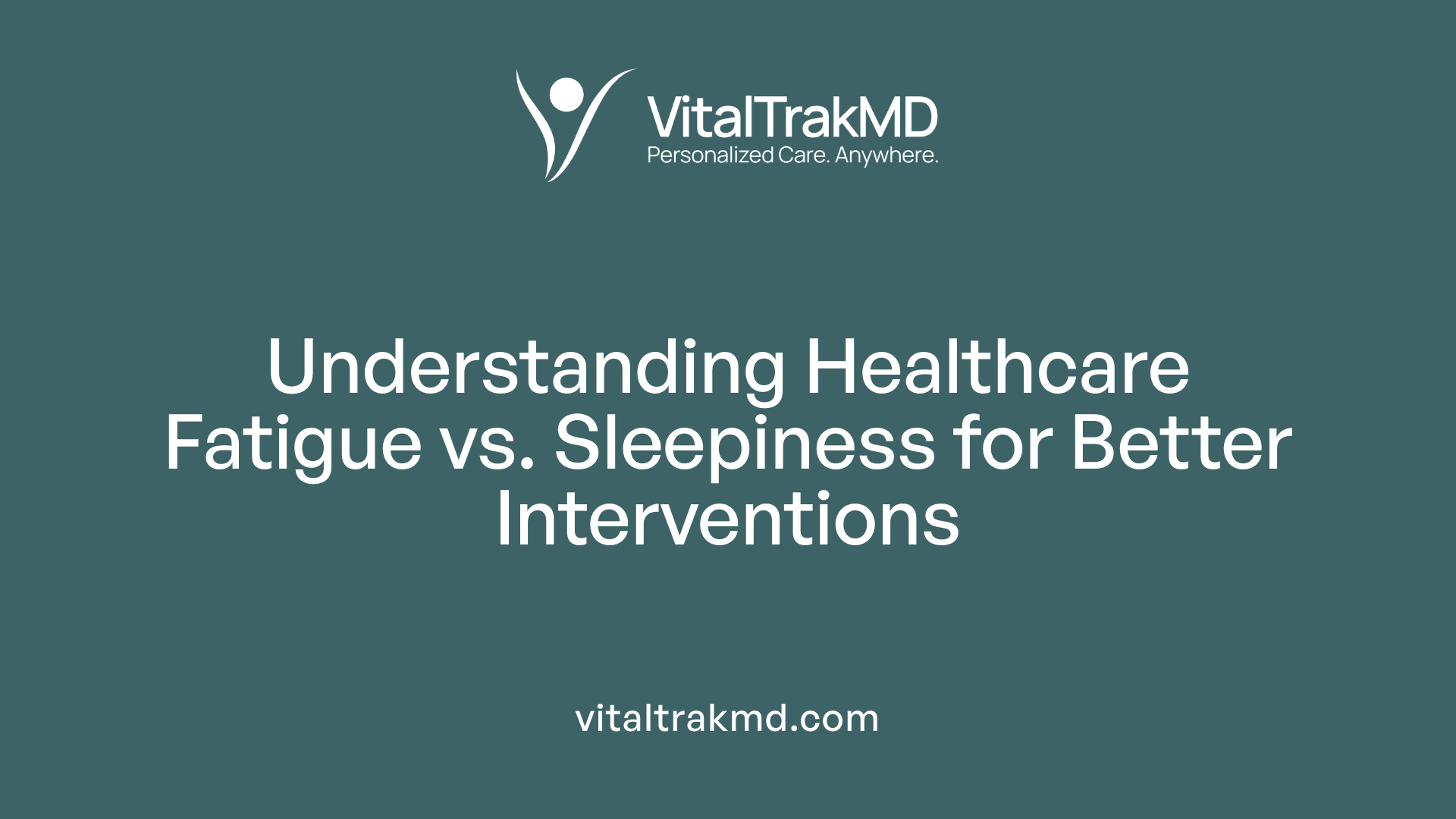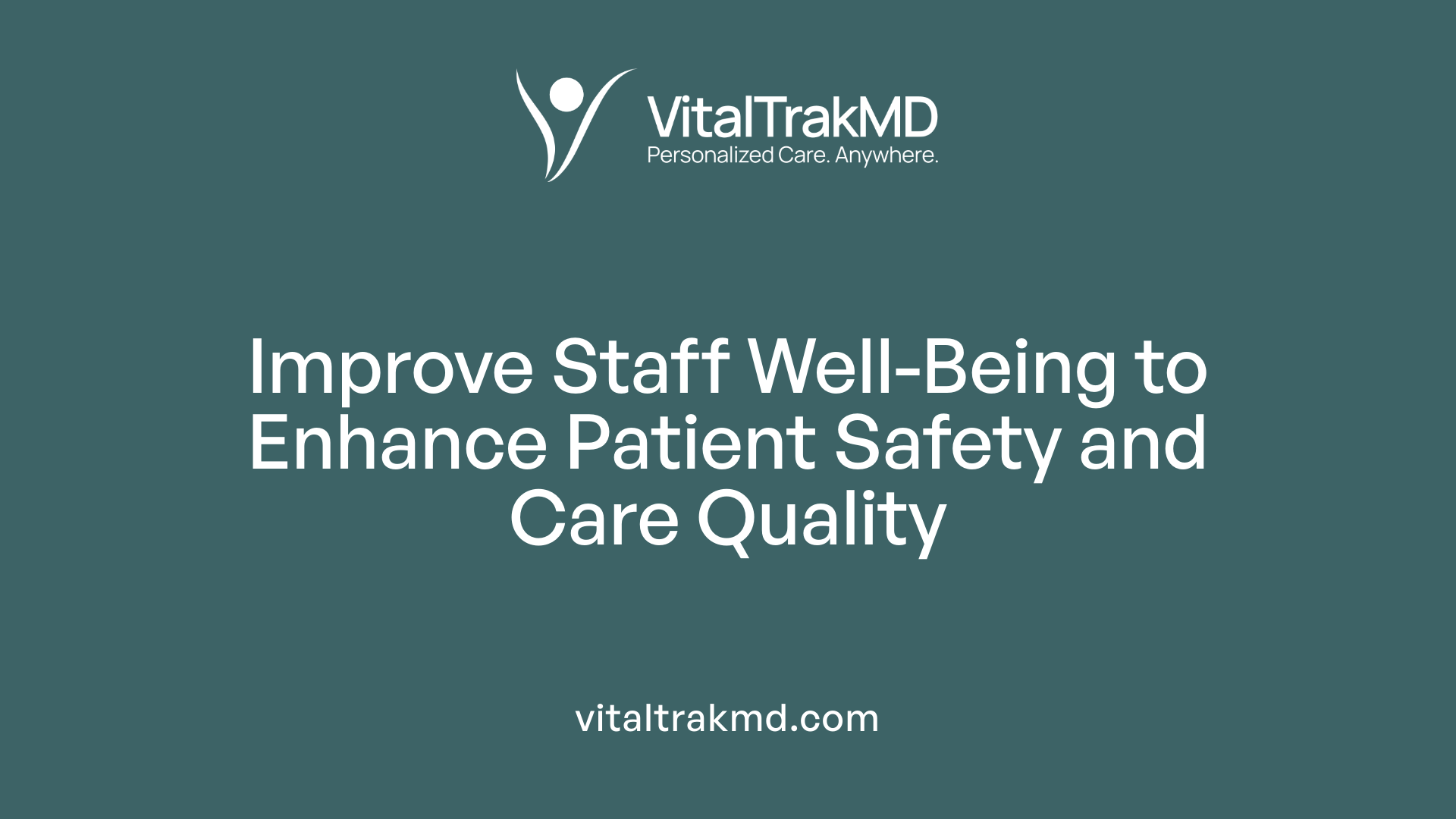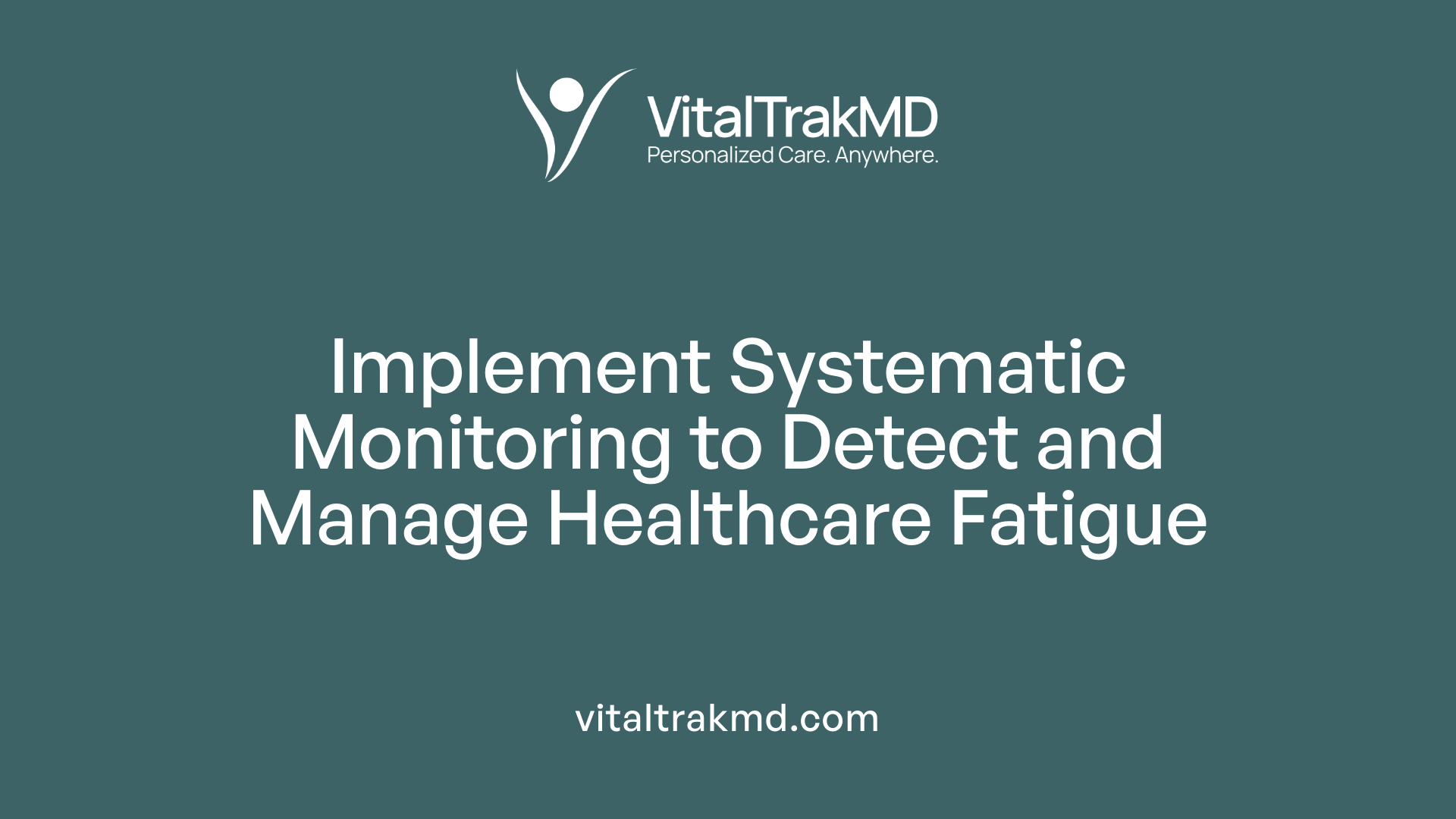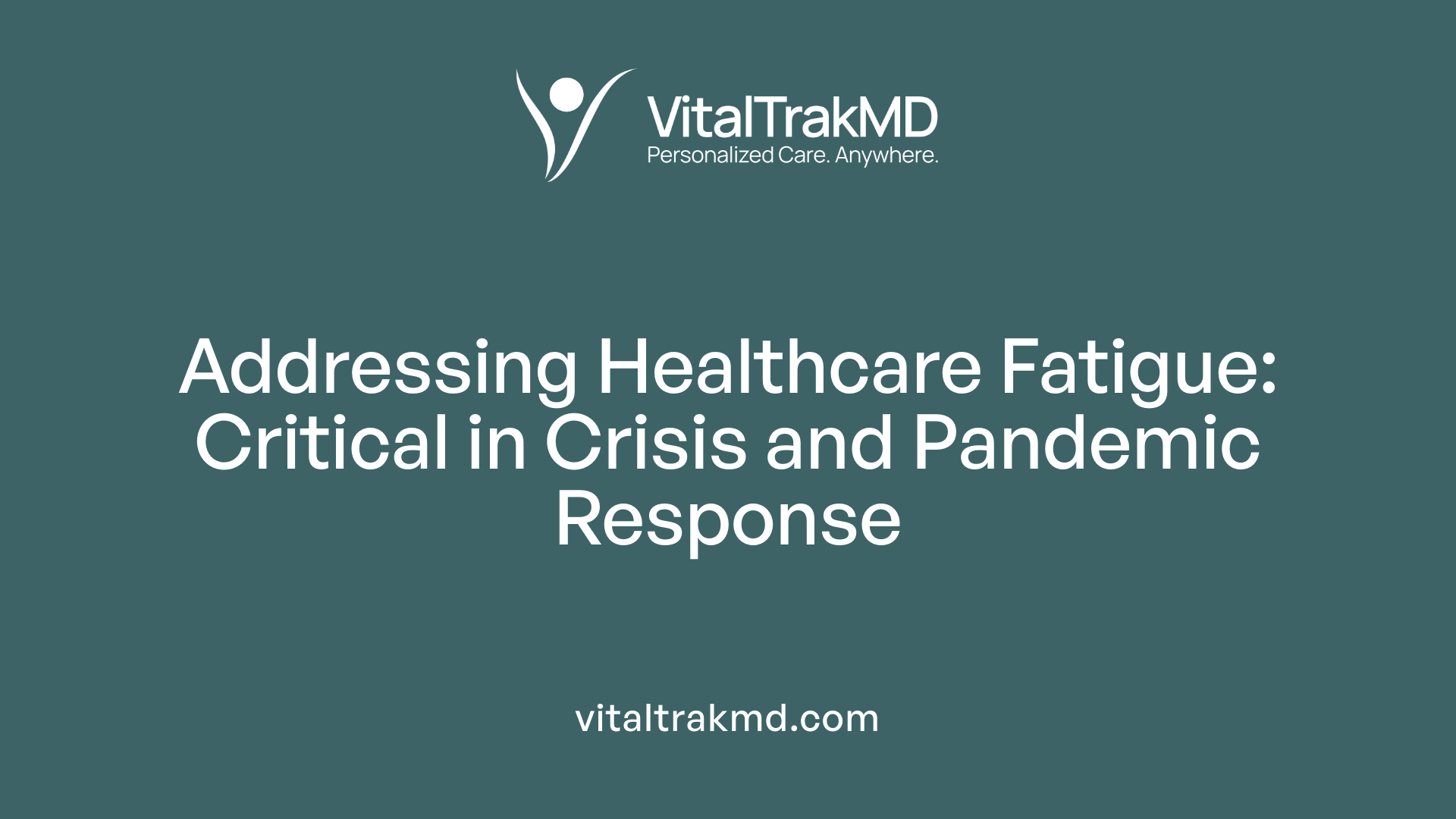Understanding Healthcare Fatigue and Its Effect on Patient Outcomes

An Overview of Healthcare Fatigue and Its Significance
Healthcare fatigue is a complex, multifaceted issue that impacts both healthcare providers and patients. Despite its critical influence on safety and quality of care, it remains underrecognized and underaddressed within healthcare systems. Understanding the causes, manifestations, and consequences of healthcare fatigue is essential to developing effective mitigation strategies and safeguarding patient outcomes.
Defining Healthcare Fatigue and Its Distinction from Sleepiness

Define healthcare fatigue
Healthcare fatigue is a state of physical and mental exhaustion that results from the high demands and stressful environment faced by healthcare professionals. It manifests when healthcare workers are overwhelmed by long shifts, irregular hours, and intense workloads. This fatigue affects their ability to maintain focus, process information accurately, and communicate effectively. As a consequence, patient safety risks increase due to errors, delays, or compromised care. Recognizing and managing healthcare fatigue is essential to ensure both staff well-being and optimal patient outcomes.
Differentiate fatigue from sleepiness
While both fatigue and sleepiness relate to tiredness, they are distinct phenomena. Sleepiness is the natural urge to sleep and is primarily caused by inadequate sleep or disrupted circadian rhythms. In contrast, fatigue refers to a profound sense of tiredness and exhaustion that impairs physical and mental performance, regardless of recent sleep. Fatigue can persist even after sleep has been obtained, especially when long hours or shift work interfere with restorative sleep cycles.
Explain how fatigue impairs physical and cognitive functioning
Fatigue hampers crucial functions necessary for safe and effective healthcare delivery. Physically, it reduces alertness, slows reaction times, and diminishes coordination, increasing the risk of slips, trips, and accidents. Cognitively, fatigue impairs decision-making, memory, attention, and problem-solving skills, which are vital for medical tasks and patient interactions. This decline in performance can lead to errors such as medication mistakes, misdiagnoses, and communication breakdowns, ultimately threatening patient safety. Furthermore, prolonged fatigue can contribute to emotional burnout, reducing empathy, and increasing the likelihood of dropouts from the workforce.
The impact of fatigue on healthcare staff and patient safety
Numerous studies underscore the adverse effects of fatigue among healthcare workers. Nurses, physicians, and other healthcare providers working extended shifts exhibit higher rates of errors, near misses, and injuries. For example, fatigue has been linked with increased medication errors, patient falls, and hospital-acquired infections. Staff fatigue also correlates with higher sick leave and intention to leave, further straining healthcare systems.
Mitigation strategies and current challenges
Many organizations implement measures such as scheduled naps, caffeine consumption, and rest breaks to temporarily boost alertness. However, the long-term effectiveness of these strategies remains uncertain. Recognizing fatigue as a systemic risk factor, some sectors like aviation or transportation incorporate comprehensive fatigue management systems, but healthcare lag behind.
Organizational approaches and the need for cultural change
Effective management of healthcare fatigue requires organizational commitment. Policies should limit shift lengths—ideally to no more than 12 hours—ensure adequate rest periods, and foster a safety culture that encourages reporting and discussion of fatigue signs. Integrating health and safety initiatives, providing ergonomic workspaces, and leveraging technology like wearable devices or AI can help monitor and predict fatigue. Education about sleep hygiene and fatigue risks is also crucial.
| Aspect | Details | Additional Insights |
|---|---|---|
| Causes of healthcare fatigue | Long shifts, night work, high workload | Contributing factors include staff shortages and organizational culture |
| Symptoms in staff | Headaches, sleep disturbances, irritability | Manifestations impact mood, performance, and patient safety |
| Consequences for patients | Errors, infection rates, patient dissatisfaction | Fatigue can undermine care quality and safety |
| Mitigation strategies | Rest breaks, naps, light therapy | Effectiveness varies; need for systemic change |
| Organizational actions | Limit work hours, monitor workload, promote safety culture | Cross-sector lessons emphasize systems approach |
In conclusion, addressing healthcare fatigue requires a comprehensive strategy that considers organizational policies, cultural norms, and technological tools. Recognizing its detrimental effects on both staff and patients is the first step toward creating safer and healthier healthcare environments.
Root Causes and Contributing Factors of Healthcare Staff Fatigue
What are the main causes and contributing factors of healthcare fatigue among staff?
Healthcare staff fatigue is a pervasive challenge in the medical field, driven mainly by extended working hours, unpredictable schedules, and high emotional and physical demands. Nurses, physicians, and other healthcare workers often endure long shifts that surpass standard hours, including mandatory overtime, night shifts, and rotating schedules. These demanding schedules disrupt normal sleep patterns, leading to insufficient rest and recovery.
Staff shortages significantly exacerbate fatigue levels. When patient-to-staff ratios are high, each worker faces increased workload, which not only heightens physical exhaustion but also elevates emotional stress. During crises like the COVID-19 pandemic, these issues intensified with increased patient loads and resource constraints. The surge in work demands, coupled with administrative burdens such as documentation and protocol adherence, leaves little room for rest.
Unlike safety-critical industries such as aviation or transportation, healthcare systems often lack formal, systematic fatigue management policies. This absence means that fatigue remains an under-recognized and undertreated risk factor. Moral injury from witnessing suffering, end-of-life care, and moral conflicts further contribute to mental exhaustion. A culture that stigmatizes mental health and encourages overworking under the guise of dedication worsens the problem.
Addressing these root causes involves recognizing fatigue as a significant occupational hazard. Implementing comprehensive fatigue risk management systems, adjusting staffing models, and promoting organizational accountability are essential steps. These measures should focus on workload redistribution, ensuring sufficient recovery periods, and fostering an environment where staff can openly discuss and address fatigue-related concerns.
How do organizational norms and culture influence perceptions of fatigue among healthcare workers?
In many healthcare settings, long-standing cultural norms have equated heroism with working excessive hours and prioritizing patient care over personal well-being. Such norms often frame fatigue as a sign of resilience and dedication, thus normalizing it and preventing acknowledgment of its dangers.
This culture discourages open discussions about fatigue and mental health issues, leading to underreporting and a lack of targeted interventions. Healthcare workers might fear stigma or judgment for admitting to exhaustion or needing rest, perceiving these admissions as signs of weakness or incompetence.
Moreover, the glorification of relentless work ethic fosters an environment where seeking help or taking breaks is viewed as a lack of commitment. This can hamper efforts to implement protective measures like scheduled breaks, adequate shift durations, and rest facilities.
Organizations advocating for a positive safety culture—where staff well-being is prioritized and fatigue is recognized as a risk—are better positioned to address these challenges. Cultivating an environment that encourages transparency, supports mental health, and normalizes seeking help can shift norms and improve staff resilience.
| Aspect | Impact | Suggested Organizational Approach |
|---|---|---|
| Work hours and scheduling | Longer shifts and night work impair sleep and recovery | Implement limits on shift length; encourage work-life balance |
| Staffing levels | Shortages increase workload and fatigue | Increase staffing; optimize staffing ratios |
| Organizational culture | Heroism culture normalizes fatigue | Promote safety culture; openly address fatigue risks |
| Mental health stigma | Discourages seeking help | Normalize mental health support; provide confidential resources |
| Crisis response (e.g., COVID-19) | Exacerbates workload and distress | Develop contingency plans and support systems |
Understanding and transforming organizational norms can significantly influence how healthcare staff perceive and manage fatigue, leading to safer and healthier work environments.
Impact of Healthcare Staff Well-being on Patient Safety and Care Quality

How does healthcare provider well-being relate to patient safety and quality of care?
The health and well-being of healthcare providers are vital factors influencing patient safety and the overall quality of care. When clinicians experience high levels of burnout, fatigue, or emotional exhaustion, the quality of their work diminishes. These states are associated with decreased attention to detail, slower reaction times, and impaired decision-making, all of which increase the likelihood of medical errors.
Organizational issues such as staffing shortages, excessive workload, and poor management practices contribute significantly to provider stress and burnout. This, in turn, impacts teamwork, communication, and adherence to safety protocols.
Efforts to improve working conditions—by ensuring adequate staffing, fostering supportive leadership, and cultivating positive organizational culture—are crucial. Creating a supportive environment enhances clinicians’ mental and physical health, which correlates with better patient outcomes.
Research consistently shows that improving provider well-being reduces errors, enhances safety, and results in higher patient satisfaction. These strategies benefit not only the clinicians but also the patients they serve, establishing a safer and more effective healthcare system.
What is the relationship between healthcare staff fatigue and the incidence of medical errors?
Fatigue among healthcare staff strongly correlates with an increased rate of medical errors and adverse events, affecting both patient safety and staff well-being. When clinicians work long hours or night shifts, their cognitive functions decline. This includes attention span, vigilance, and response time, all critical components necessary for safe practice.
Sleep deprivation and extended work hours contribute to microsleeps—brief episodes of sleep—and reduced situational awareness, which can lead to mistakes such as medication errors, missed diagnoses, or procedural errors.
Several studies reveal that physicians experiencing fatigue are significantly more prone to errors, with some reporting more than double the likelihood of making mistakes compared to rested colleagues. For instance, nurses working extended shifts show higher rates of medication errors, patient falls, and other adverse events.
Addressing healthcare fatigue requires systemic changes, including shift length restrictions, adequate rest periods, and targeted fatigue management interventions. These measures help maintain alertness and cognitive capacity, thereby reducing errors and safeguarding patient well-being.
| Aspect | Impact | Addressing Strategies |
|---|---|---|
| Staff Well-being | Directly linked to patient safety; affects error rates, teamwork, and care quality | Improve staffing, foster organizational support, promote mental health initiatives |
| Fatigue | Leads to impaired cognition, vigilance, decision-making | Limit shift length, enforce rest breaks, utilize fatigue monitoring tools |
| Outcomes | Lower errors, fewer adverse events, higher patient satisfaction | Implement fatigue risk management systems, provide fatigue awareness education |
By understanding and addressing these factors, healthcare organizations can foster safer care environments, improve staff health, and enhance overall treatment outcomes.
Physiological and Cognitive Impact of Fatigue on Medical Staff
What is healthcare fatigue and how does it affect healthcare providers and patient safety?
Healthcare fatigue is a state of physical and mental exhaustion that healthcare providers experience due to demanding work schedules, long shifts, and high workloads. It significantly impairs their attention, memory, decision-making, and communication skills. When staff are fatigued, their vigilance decreases, reaction times slow down, and their overall clinical performance diminishes. These impairments directly threaten patient safety, as mistakes become more likely, including medication errors, delayed responses, and procedural oversights.
Managing healthcare fatigue requires organizational efforts such as enforcing work-hour limits, providing adequate rest and recovery periods, and promoting strategies like scheduled naps and breaks. Recognizing early signs of fatigue and fostering a culture that prioritizes staff well-being are essential steps. Although various interventions are in place, their effectiveness varies, highlighting the importance of supportive leadership and systemic changes to reduce burnout and improve safety outcomes.
How does sleep deprivation influence clinical performance among healthcare professionals?
Sleep deprivation has profound effects on the cognitive and physical capabilities of healthcare workers. It decreases reaction times, making responses to urgent situations slower and less accurate. Additionally, sleep loss impairs reasoning skills, problem-solving, and critical thinking, all crucial for safe patient care.
Research indicates that sleep deprivation can mimic intoxication; for instance, it raises blood alcohol levels to the point where an individual might be legally impaired. This impairment poses a major risk during high-stakes procedures, medication management, and decision-making tasks.
The consequences include increased likelihood of errors such as incorrect medication dosing, missed diagnoses, and procedural mistakes. Sleep-deprived staff are often less alert, more prone to microsleeps—brief lapses in attention—and less capable of multitasking efficiently. Ensuring adequate sleep and recovery time is therefore vital to uphold high care standards, reduce errors, and protect patient safety.
Effects on decision-making and reactions
Fatigue severely impacts both decision-making and reaction times. When fatigued, healthcare providers tend to rely on habitual responses rather than careful analysis. This can lead to rash or suboptimal decisions, especially in emergency situations requiring rapid judgment.
Reaction time, a crucial element in responding to patient needs swiftly, increases significantly under fatigue. For example, a fatigued nurse may react slowly to a deteriorating vital sign or an emergency call, delaying interventions. These delays can have serious consequences for patient outcomes.
How fatigue mimics intoxication
One particularly concerning aspect of fatigue is its similarity to intoxication. Sleep deprivation impairs cognitive and motor functions to a degree comparable with alcohol consumption. For instance, individuals deprived of sleep for 24 hours can have reaction times and decision-making abilities equivalent to someone with a blood alcohol concentration of approximately 0.10%, over the legal limit.
This comparison underscores the danger of fatigued healthcare workers operating machinery, driving home after shifts, or performing procedures. Just as intoxication hampers alertness and motor skills, fatigue diminishes these capabilities, increasing the risk of accidents, injuries, and errors. Recognizing that fatigue can produce impairments similar to intoxication emphasizes the need for strict management of work hours and recovery periods.
| Aspect | Impact | Additional Details |
|---|---|---|
| Cognitive performance | Slowed reaction times, impaired reasoning, poor decision-making | These effects compromise clinical judgment and efficiency |
| Physical performance | Reduced motor coordination, microsleeps | Critical during procedures and operating equipment |
| Reaction times | Significantly delayed responses | Leads to missed cues and slower interventions |
| Mimicking intoxication | Similar impairments in alertness and motor skills | Equates to legal intoxication levels, increasing safety risks |
Current research highlights the complex ways fatigue undermines the cognitive and physical functioning of healthcare staff. Addressing this issue is essential for safeguarding both providers and patients, demanding a robust, system-wide approach to reduce fatigue and its detrimental effects.
Countermeasures and Strategies to Mitigate Healthcare Fatigue
What organizational, technological, and management strategies can be implemented to mitigate healthcare fatigue?
Healthcare organizations are recognizing the importance of managing staff fatigue to ensure patient safety and staff well-being. A comprehensive approach includes managing workloads effectively by maintaining adequate staffing levels, limiting shift durations to no more than 12 hours, and ensuring mandatory rest periods between shifts. Promoting a healthy work-life balance, providing access to mental health support, and fostering a supportive work environment are critical components.
Leadership plays a vital role in cultivating a safety-oriented culture that encourages open dialogue about fatigue-related concerns. Policies that emphasize sleep hygiene, schedule flexibility, and wellness programs can help reduce burnout. Implementing fatigue management programs that include regular monitoring of fatigue symptoms, educational sessions on stress management, and access to relaxation techniques like mindfulness and stress reduction exercises are also beneficial.
Furthermore, organizational strategies should prioritize safe staffing ratios and incorporate organizational accountability for fatigue risks. This includes reviewing workload distribution and offering secondary support during peaks in demand. Additionally, promoting peer support systems helps create a community where healthcare staff can share concerns and develop solutions collectively.
How can technological innovations assist in managing healthcare staff fatigue?
Technological advancements provide numerous tools to proactively monitor and address fatigue among healthcare professionals. Wearable devices, such as fitness trackers and smart watches, can continuously monitor physiological indicators like sleep quality, heart rate, and activity levels. These devices generate data that can reveal early signs of fatigue or sleep deprivation.
Mobile apps and online platforms offer self-assessment tools, fatigue tracking, and personalized recommendations for rest and recovery. Artificial Intelligence (AI) and machine learning algorithms analyze aggregated data from various sources — including workload, shift patterns, and physiological metrics — to develop predictive models. These models can identify high-risk periods for staff fatigue and suggest optimal staffing schedules to prevent overwork.
Virtual reality (VR) training modules can simulate high-stress scenarios and teach self-awareness, relaxation techniques, and fatigue mitigation strategies in a controlled environment. Automated alert systems integrated into clinical workflows can notify staff or supervisors of signs of excessive fatigue or errors linked to fatigue, providing a real-time safety net.
The integration of these technologies enables healthcare organizations to shift from reactive to proactive fatigue management, minimizing risks for both staff and patients. However, effective implementation requires leadership commitment, staff training, and data privacy considerations.
| Strategy Type | Example Technologies | Benefits | Challenges |
|---|---|---|---|
| Wearable Devices | Fitness trackers, smart watches | Real-time physiological data, early fatigue detection | Privacy concerns, staff acceptance |
| Predictive Analytics | AI-based scheduling tools | Optimized shift planning, prevent overwork | Data accuracy, technical integration |
| Training & Simulation | VR modules | Stress management, fatigue awareness | Cost, accessibility |
| Automated Alerts | Clinical monitoring systems | Immediate response to fatigue signs | Alert fatigue, false positives |
What personal and behavioral strategies can be used to reduce fatigue?
On an individual level, healthcare workers can adopt several strategies to mitigate fatigue. Prioritizing good sleep hygiene, such as maintaining a consistent sleep schedule, creating a restful environment, and avoiding stimulants before bedtime, helps improve sleep quality.
Engaging in regular physical activity, such as light exercise or stretching, can boost energy levels and reduce stress. Short naps during breaks, ideally 20-30 minutes long, have been shown to temporarily restore alertness and cognitive function.
Practicing mindfulness, relaxation exercises, and deep-breathing techniques can help manage stress and emotional fatigue. Managing workload by setting boundaries, seeking support when needed, and taking advantage of available mental health services can further reduce burnout.
Adjusting personal habits, such as maintaining good nutrition and hydration, also supports physical resilience. Developing a self-awareness of fatigue signs encourages timely intervention and prevents exhaustion.
How does organizational culture and leadership influence fatigue management?
A positive safety culture anchored in leadership commitment is crucial for effective fatigue management. Leaders who openly acknowledge staff fatigue as a legitimate safety concern foster an environment where staff feel comfortable reporting fatigue without fear of blame.
Promoting transparency, continuous education, and supportive communication helps normalize discussions about fatigue and mental health. Strong leadership demonstrates organizational accountability for creating staffing policies aligned with staff health needs.
Supporting initiatives such as mentorship programs, peer support groups, and recognition systems boosts morale and reduces feelings of isolation. Encouraging feedback from healthcare workers about workload and fatigue-related issues leads to actionable improvements.
Leaders should also support organizational policies that facilitate access to wellness resources, flexible scheduling, and sufficient rest opportunities, signaling that staff well-being is a priority. This cultural shift not only reduces fatigue but also enhances overall safety, staff satisfaction, and retention.
The Link between Healthcare Fatigue, Medical Errors, and Patient Harm
How is healthcare fatigue related to medical errors and adverse events?
Healthcare fatigue significantly increases the risk of medical errors and adverse events. When healthcare providers, especially nurses and physicians, become fatigued, their cognitive functions—which include attention, vigilance, response time, and decision-making—are impaired. This decline in mental acuity can lead to medication errors, procedural mistakes, and near-misses that endanger patient safety.
Shift work, extended work hours, especially those exceeding 12 hours, and sleep deprivation are major contributors to fatigue. These factors can cause microsleeps and reduce situational awareness, meaning healthcare workers may miss critical cues or misjudge situations. Such lapses can easily result in harmful clinical mistakes.
Research shows that physician burnout linked to fatigue correlates with more than double the likelihood of self-reporting making medical errors. Nurses experiencing high fatigue levels are also more prone to errors, which can translate into medication mishaps, incorrect diagnoses, or procedural oversights.
Ultimately, ineffective management of workload and sleep deprivation fosters a dangerous environment for patient safety. Addressing fatigue not only improves individual performance but also reduces the likelihood of serious adverse events.
What organizational policies are recommended to address medical errors stemming from staff fatigue?
To combat errors caused by staff fatigue, healthcare organizations should adopt comprehensive policies focused on systemic change. These can include:
- Limiting shift lengths to no more than 12 hours to reduce fatigue and cognitive decline.
- Ensuring adequate rest periods between shifts to promote recovery and alertness.
- Implementing fatigue risk management systems that monitor workload and alertness levels among staff.
- Providing education on sleep hygiene, stress management, and fatigue awareness to empower staff to recognize and address their own fatigue.
- Fostering a safety culture where staff feel comfortable reporting fatigue without fear of blame or punishment.
- Utilizing technological solutions such as wearable fatigue monitoring devices and predictive algorithms powered by AI to anticipate fatigue patterns and optimize staffing schedules.
- Regular review of error reports to identify fatigue-related trends and implement targeted interventions.
- Enhancing teamwork and communication strategies, ensuring that fatigue-related concerns are promptly addressed during handoffs and team interactions.
These policies serve as part of a holistic approach to safeguard both staff well-being and patient safety. Establishing clear guidelines and a supportive environment encourages proactive management of fatigue risks, ultimately leading to fewer errors and better patient outcomes.
Monitoring and Assessing Healthcare Staff Fatigue

What measures can be used to assess and monitor healthcare staff fatigue?
Effective management of staff fatigue requires systematic assessment strategies that can identify those at risk of exhaustion or diminished alertness. Similar to practices in other safety-critical industries, healthcare organizations need to adopt comprehensive methods for monitoring fatigue. These include regular physical, emotional, and mental exhaustion evaluations through observation, self-reporting tools, and standardized assessment instruments.
Observations by supervisors can help spot signs such as reduced concentration, microsleeps, or irritability. Self-reporting questionnaires like the Fatigue Severity Scale or the Epworth Sleepiness Scale enable staff to communicate their perceived fatigue levels anonymously or directly. Advanced approaches incorporate technological tools such as wearable devices that track sleep quality and quantity, or electronic scheduling systems that analyze workload and shift patterns.
Implementing fatigue risk management systems (FRMS) that integrate these data points allows organizations to identify high-risk periods or individuals. These systems can include regular monitoring protocols, alerts when fatigue thresholds are reached, and data-driven decision-making for staffing adjustments. Additionally, educational programs increase awareness among staff and managers about the importance of recognizing early signs, further supporting ongoing assessment efforts.
Overall, creating a culture where fatigue is systematically tracked through multiple methods fosters a safer working environment and enhances patient safety outcomes.
How can leadership support ongoing fatigue surveillance within healthcare settings?
Strong leadership commitment is essential for sustaining effective fatigue management strategies. Leaders set the tone by establishing policies that prioritize staff health and safety as integral to organizational performance.
One of the primary roles of leadership is mandating regular fatigue evaluations as part of routine staff assessments. This can include requiring the use of wearable sleep sensors or electronic fatigue monitoring tools and reviewing data during management meetings. Leaders also promote open communication channels that encourage staff to report fatigue-related concerns without fear of blame or repercussions.
Promoting a safety culture involves training supervisors and staff to recognize fatigue signs early and act accordingly. Additionally, integrating fatigue-related data into organizational quality metrics ensures that staff well-being becomes a visible priority. Leaders can also utilize technological advances—such as real-time alerts from fatigue monitoring devices—and incorporate these into staffing decisions.
Creating policies that incentivize adequate rest, limit extended shifts, and allow flexible scheduling demonstrates organizational support for fatigue surveillance. Ultimately, sustained leadership engagement fosters an environment where ongoing fatigue assessment is embedded into daily operations, reducing risks and improving overall safety for both staff and patients.
| Method of Assessment | Description | Organizational Role |
|---|---|---|
| Observation | Supervisors monitor staff for physical and behavioral signs of fatigue | Enable early detection, guide immediate interventions |
| Self-Report Tools | Questionnaires and surveys patients complete regarding their alertness | Cultivate self-awareness, improve reporting |
| Wearable Devices | Technology that tracks sleep and activity patterns | Provide objective data to inform scheduling |
| Shift Scheduling Analysis | Reviewing workload and shift length data | Prevent fatigue accumulation by optimizing rosters |
| Fatigue Risk Management Systems | Integrated platforms combining data points for risk analysis | Support proactive organizational strategies |
Efforts to systematically assess and monitor staff fatigue require organizational backing, technological investment, and a culture that values safety and staff well-being. When leadership actively supports these initiatives, healthcare systems can better protect their workers and improve patient outcomes.
Research and Evidence on Healthcare Fatigue Impact and Interventions

What scientific research and evidence exist regarding healthcare fatigue and its impact on healthcare outcomes?
Extensive research has established a clear connection between healthcare worker fatigue—particularly burnout and sleep deprivation—and negative patient and organizational outcomes. Studies involving nurses and physicians show that fatigue substantially increases the likelihood of medical errors, adverse events, hospital-acquired infections, and overall lower patient satisfaction levels.
For instance, a systematic review analyzing 85 studies with nearly 289,000 nurses from 32 countries found a consistent association between nurse burnout and poorer safety climate, increased medication errors, and more nosocomial infections. Burnout's emotional exhaustion and depersonalization elements are especially linked to decreased safety and care quality.
Sleep loss is another critical factor. Healthcare staff working extended shifts and irregular hours report impaired cognition, reduced vigilance, slow reaction times, and diminished decision-making abilities. These impairments directly elevate risks such as medication errors and patient safety breaches.
Despite the high risks, healthcare settings often lack systematic tools and policies to manage fatigue effectively. In comparison, other safety-critical sectors like aviation and nuclear power have well-established fatigue management systems emphasizing organizational responsibility.
Overall, the accumulated evidence underscores that addressing fatigue in healthcare is crucial for improving patient safety, enhancing staff well-being, and maintaining care quality.
What research gaps exist in understanding healthcare fatigue and its effects?
While current studies clearly link fatigue with safety and performance issues, significant gaps hinder comprehensive understanding and policy development. Most existing research is cross-sectional, offering snapshots rather than insight into long-term effects or causality.
There is a notable absence of standardized, healthcare-specific fatigue measurement tools. Without consistent metrics, comparing data across different health systems, staff groups, and geographic locations becomes challenging.
Additionally, much of the research focuses on nurses, with less attention paid to physicians, allied health workers, and multidisciplinary teams. This limits understanding of the full scope of healthcare fatigue.
Interventional studies are scarce, especially randomized controlled trials assessing the efficacy of fatigue mitigation strategies such as scheduled naps, shift scheduling adjustments, or organizational interventions.
Addressing these gaps through longitudinal research, standardized assessment tools, and diverse staff inclusion will be critical for developing effective programs and policies to minimize fatigue-related risks.
| Aspect | Current Status | Future Needs | Additional Notes |
|---|---|---|---|
| Study Design | Mostly cross-sectional, limited longitudinal data | Long-term studies, causality-focused research | Needed to understand fatigue's long-term effects |
| Measurement Tools | Lack of standardized metrics tailored to healthcare settings | Development of validated, healthcare-specific fatigue assessment instruments | Will improve comparison and policy effectiveness |
| Staff Groups | Focus mainly on nurses | Broader inclusion of physicians, allied health staff, and teams | Supports comprehensive understanding |
| Intervention Evidence | Limited rigorous trials of fatigue interventions | More randomized controlled trials and outcome evaluations | Guides effective policy and practice |
| Overall Research Gaps | Gaps in longitudinal data, standardization, and intervention studies | Prioritized research to fill these gaps | Will enable robust, evidence-based strategies |
Understanding and tackling healthcare fatigue require coordinated efforts rooted in a solid scientific foundation. Bridging these research gaps will pave the way for safer, more resilient healthcare systems.
Special Challenges During Crises and Pandemics

What are the implications of healthcare fatigue during crisis situations such as pandemics?
Healthcare fatigue during crises like the COVID-19 pandemic has profound effects on both healthcare workers and patient safety. As the pandemic strained healthcare systems worldwide, staff faced unprecedented workloads, extended shifts, and emotional stressors that intensified fatigue levels. This persistent exhaustion increased the likelihood of burnout and depressive symptoms among healthcare professionals, which often lingered long after the peak of the crisis.
When healthcare workers are severely fatigued, their ability to deliver high-quality care diminishes. Error rates in medication administration, diagnostic accuracy, and decision-making tend to rise. These mistakes can lead to adverse patient outcomes, including complications, prolonged hospital stays, or even mortality.
Furthermore, fatigue impairs cognitive and emotional functioning, increasing the risk of accidents within healthcare facilities and even on the way home for staff. For particular vulnerable groups such as women and minority populations, the impact may be more severe due to existing health disparities.
The consequences of unaddressed healthcare fatigue extend beyond individual workers to the entire health system. Reduced staffing levels due to early retirements or mental health issues contribute to workforce shortages. Emergency preparedness is compromised when staff are unable to maintain optimal alertness and decision-making capacity during critical moments.
To mitigate these risks, there is an urgent need for systematic approaches that include real-time fatigue monitoring, mental health support, and organizational policies geared toward sustainable staffing. Implementing crisis-specific mitigation strategies such as flexible shifts, targeted rest periods, and resilience training can help preserve healthcare quality and safety during times of systemic stress.
Overall, understanding the implications of healthcare fatigue in emergencies is essential for developing effective policies and interventions. Recognizing fatigue as an acute risk factor during crises allows healthcare organizations to prioritize staff well-being, which directly impacts patient safety, staff retention, and future emergency response capabilities.
How system pressures exacerbate fatigue
During crises, healthcare systems face tremendous pressures, including surging patient loads, resource shortages, and heightened emotional demands. These factors compound fatigue by forcing staff to work longer hours and take fewer breaks.
High patient volumes stretch staffing thin, often requiring healthcare workers to perform extended shifts or work consecutive days. Such schedules interfere with normal sleep patterns, leading to chronic sleep deprivation.
Limited access to personal protective equipment (PPE) and other essential resources adds to stress levels and psychological fatigue. Caregivers frequently encounter difficult moral dilemmas, including rationing care, which exacerbates emotional exhaustion.
The lack of organizational support, inadequate rest facilities, no enforced limits on shift lengths, and insufficient mental health resources further intensify fatigue. Inadequate leadership engagement and low safety culture perception can diminish staff trust and willingness to report fatigue or concerns.
Such systemic issues not only impair individual alertness but also undermine team coordination and overall safety. The greater the systemic pressures, the higher the risk of errors, injuries, and burnout.
Importance of crisis-specific mitigation strategies
Given these challenges, adopting targeted mitigation measures is vital during crises. These include establishing rapid fatigue assessment protocols, promoting mental health resilience, and designing flexible staffing models.
Specific strategies involve:
- Implementing mandatory rest periods after long shifts.
- Utilizing technology like wearable sensors to monitor fatigue levels.
- Offering telehealth support and counseling services for stressed staff.
- Creating recovery zones where staff can rest or nap during breaks.
- Developing adaptive scheduling tools that account for workload and circadian rhythms.
Organizational leadership must foster a safety culture that proactively recognizes fatigue signs and encourages reporting without blame. Training staff on sleep hygiene, stress management, and resilience can enhance their ability to cope during prolonged crises.
Additionally, policymakers should consider regulatory adjustments to limit shift durations and mandate minimum rest requirements during emergencies.
In conclusion, effective management of healthcare fatigue during crises demands a comprehensive, systemic approach that addresses both operational and mental health needs. Recognizing and mitigating fatigue in these critical times safeguard not only the well-being of healthcare workers but also the safety and quality of care provided to patients.
Holistic Approaches to Tackling Healthcare Fatigue
Addressing healthcare fatigue necessitates a comprehensive and systemic approach that encompasses organizational policies, technological innovations, cultural shifts, and individual strategies. Recognizing fatigue as a significant safety risk and implementing targeted interventions can significantly improve patient outcomes, enhance provider well-being, and foster a resilient healthcare system capable of withstanding crises. Future research should focus on developing robust, evidence-based fatigue management frameworks that are adaptable across diverse healthcare settings, ensuring that provider well-being remains central to quality and safety initiatives.
References
- The Effects of Fatigue and Sleepiness on Nurse Performance ... - NCBI
- Nurse Fatigue and Nurse, Patient Safety, and Organizational ...
- Healthcare staff fatigue: The unrecognised risk for patient safety
- Nurse Burnout and Patient Safety, Satisfaction, and Quality of Care
- Nurse fatigue and injury prevention
- Managing Fatigue During Times of Crisis: Guidance for Nurses ...
- Nurse Fatigue and Patient Safety | NSO
- Burnout Among Health Professionals and Its Effect on Patient Safety
- The impact of staff fatigue on patient safety
Recent articles
Want to Feel Better and Live Healthier?
Join hundreds of patients taking control of their health with personalized care that fits their life – not the other way around.
Rated 4.8/5 by 32+ customers







